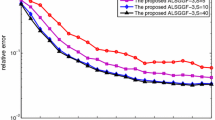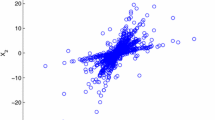Abstract
The generic statistics, related to lower-order derivatives of the log characteristic function (CAF) evaluating at the processing points located away from the origin, are frequently used in multivariate statistical signal processing. In comparison with the conventional statistics, e.g., cumulants, the generic statistics have the following advantages: (a) they can offer the structural simplicity and controllable statistical stability of lower-order statistics, and retain higher-order statistical information; (b) if the derivatives of the log CAF were evaluated at all (infinitely many) possible processing-points, a complete description of the joint CAF would be obtained. Furthermore, we show in this paper that even if a random process is symmetrically distributed, the odd-order generic statistics are not equal to zero, while in such a case the odd-order cumulants are equal to zero. For these reasons, a family of blind identification (BI) methods, in which the mixing matrix is obtained by decomposing the tensor constructed by the higher order derivatives of the log CAF of the observations, is proposed to achieve BI of underdetermined mixtures. Simulation results show that the BI methods based on generic statistics have superior performance to the existing cumulant-based method, such as FOOBI method, especially, when the SNR of the observations is high and/or the data block is short.







Similar content being viewed by others
References
A. Aissa-EI-Bey, N. Linh-Trung, K. Abed-Meraim, A. Belouchrani, Y. Grenier, Underdetermined blind separation of nondisjoint sources in the time-frequency domain. IEEE Trans. Signal Process. 55(3), 897–907 (2007)
L. Albera, A. Ferreol, P. Comon, P. Chevalier, Sixth order blind identification of under-determined mixtures (BIRTH) of sources, in 4th International Symposium on Independent Component Analysis and Blind Signal Separation, Nara, Japan, pp. 909–914 (2003)
L. Albera, A. Ferréol, P. Comon, P. Chevalier, Blind identification of over-complete mixtures of sources (BIOME). Linear Algebra Appl. 391, 1–30 (2004)
D. Astèly, A.L. Swindlehurst, B. Ottersten, Spatial signature estimation for uniform linear arrays with unknown receivers gains and phases. IEEE Trans. Signal Process. 47(8), 2128–2138 (1999)
A. Belouchrani, K. Abed-Meraim, J.F. Cardoso, E. Moulines, A blind source separation technique using second-order statistics. IEEE Trans. Signal Process. 45(2), 434–444 (1997)
Y. Chen, D. Han, L. Qi, New ALS methods with extrapolating search directions and optimal step size for complex-valued tensor decompositions. IEEE Trans. Signal Process. 59(12), 5888–5898 (2011)
P. Comon, M. Rajih, Blind identification of underdetermined mixtures based on the characteristic function. Signal Process. 86(9), 2271–2281 (2006)
A.L.F. de Almeida, X. Luciani, P. Comon, Blind identification of underdetermined mixtures based on the hexacovariance and higher-order cyclostationarity, in IEEE Workshop on Statistical Signal Processing, Cardiff, UK, pp. 669–672 (2009)
A.L.F. de Almeida, X. Luciani, P. Comon, Fourth-order CONFAC decomposition approach for blind identification of underdetermined mixtures, in Proceedings of 20th European Signal Processing Conference, Bucarest, Romania, pp. 709–712 (2012)
A.L.F. de Almeida, X. Luciani, A. Stegeman, P. Comon, CONFAC decomposition approach to blind identification of underdetermined mixtures based on generating function derivatives. IEEE Trans. Signal Process. 60(11), 5698–5713 (2012)
E. Eidinger, A. Yeredor, Blind MIMO identification using the second characteristic function. IEEE Trans. Signal Process. 53(11), 4067–4079 (2005)
T. Eltoft, T. Kim, T. Lee, On the multivariate Laplace distribution. IEEE Signal Process. Lett. 13(5), 300 (2006)
A. Ferréol, L. Albera, P. Chevalier, Fourth-order blind identification of underdetermined mixtures of sources (FOBIUM). IEEE Trans. Signal Process. 53(5), 1640–1653 (2005)
F. Gu, H. Zhang, D. Zhu, Blind separation of complex sources using the generalized generating function. IEEE Signal Process. Lett. 20(1), 74–77 (2013)
F. Gu, H. Zhang, W. Wang, D. Zhu, Generalized generating function with tucker decomposition and alternating least squares for underdetermined blind identification. EURASIP J. Adv. Signal Process. (2013). doi:10.1086/1687-6180-2013-124
F. Gu, H. Zhang, S. Wang, D. Zhu, Blind identification of underdetermined mixtures with complex sources using the generalized generating function. Circuits Syst. Signal Process. (2014). doi:10.1007/s00034-014-9858-6
M.I. Gurelli, C.L. Nikias, Blind identification and array processing applications of generalized higher-order statistics, in Proceedings of the Military Communication Conference, pp. 838–842 (1996)
A. Hyvärinen, E. Oja, A fast fixed-point algorithm for independent component analysis. Neural Comput. 9, 1483–1492 (1997)
A. Karfoul, L. Albera, G. Birot, Blind underdetermined mixture identification by joint canonical decomposition of HO cumulants. IEEE Trans. Signal Process. 58(2), 638–649 (2010)
T.G. Kolda, B.W. Bader, Tensor decompositions and applications. SIAM Rev. 51(3), 455–500 (2009)
L.D. Lathauwer, B.D. Moor, J. Vandewalle, On the best rank-1 and rank-(\(R_{1}, R_{2}, {\ldots }, R_{N})\) approximation of higher-order tensors. SIAM J. Matrix Anal. Appl. 21, 1324–1342 (2000)
L.D. Lathauwer, J. Castaing, J.F. Cardoso, Fourth-order cumulant-based blind identification of underdetermined mixtures. IEEE Trans. Signal Process. 55(6), 2965–2973 (2007)
L.D. Lathauwer, J. Castaing, Blind identification of underdetermined mixtures by simultaneous matrix diagonalization. IEEE Trans. Signal Process. 56(3), 1096–1105 (2008)
X. Luciani, A.L.F. de Almeida, P. Comon, Blind identification of underdetermined mixtures based on the characteristic function: the complex case. IEEE Trans. Signal Process. 59(2), 540–553 (2011)
J.M. Mendel, Tutorial on higher-order statistics (spectra) in signal processing and system theory: theoretical results and some applications. Proc. IEEE 79(3), 278–315 (1991)
D. Nion, L.D. Lathauwer, An enhanced line search scheme for complex-valued tensor decompositions: application in DS-CDMA. Signal Process. 88(3), 749–755 (2008)
M. Rajih, P. Comon, Alternating least squares identification of underdetermined mixtures based on the characteristic function, in IEEE ICASSP 2006, Toulouse, France, pp. III–117/III–120
Y. Rong, S.A. Vorobyov, A.B. Gershman, N.D. Sidiropoulos, Blind spatial signature estimation via time-varying user power loading and parallel factor analysis. IEEE Trans. Signal Process. 53(5), 1697–1710 (2005)
A. Slapak, A. Yeredor, Charrelation and charm: generic statistics incorporating higher-order information. IEEE Trans. Signal Process. 60(10), 5089–5106 (2012)
P. Tichavský, Z. Koldovský, Weight adjusted tensor method for blind separation of underdetermined mixtures of nonstationary sources. IEEE Trans. Signal Process. 59(3), 1037–1047 (2011)
K. Todros, J. Tabrikian, Blind separation of independent sources using Gaussian mixture model. IEEE Trans. Signal Process. 55(7), 3645–3658 (2007)
S. Xie, L. Yang, J. Yang, G. Zhou, Y. Xiang, Time-frequency approach to underdetermined blind source separation. IEEE Trans. Neural Netw. Learn. Syst. 23(2), 306–316 (2012)
A. Yeredor, Blind source separation via the second characteristic function. Signal Process. 80(5), 897–902 (2000)
Acknowledgments
The authors would like to thank Lieven De Lathauwer for sharing the Matlab codes of FOOBI algorithm. They also thank the anonymous reviewers for their careful reading and helpful remarks, which have contributed to improving the clarity of the paper. This work was supported in part by the Major Projects of the National Natural Science Foundation of China under Grant 91338105, and the foundation of Science and Technology on Information Transmission and Dissemination in Comm. Networks Lab.
Author information
Authors and Affiliations
Corresponding author
Appendices
Appendix A
1.1 Proof of Eq. (7)
In this Appendix, we show the computational details of equation in (7). First, the differentiation of (7) with respect to \(u_{q_{1}}\) gives
Similarly, the differentiation of (7) with respect to \((u_{q_{1}} ,u_{q_{2}} ,\ldots ,u_{q_{K}})\) gives
Defining \(C_{K,p} ={\partial ^{(K)}\left( {\varphi _{p} (\sum \nolimits _{q} {A_{qp} u_{q} } )} \right) }\big /{\partial \left( {\sum \nolimits _{q} {A_{qp} u_{q}}} \right) ^{K}}\), we can rewrite (18) in a more compact form as in (7).
Appendix B
1.1 Proof of Theorem 1
Lemma
Suppose z is a random variable with a \(K\hbox {th}\)-order cumulant. Then, for any \(b\in {R}, z+b\) has a \(K\hbox {th}\)-order cumulant and
Proof
According to the definition of the generating function in (2), we obtain
Since \(C_{K,z} ={{\hbox {d}}^{(K)}\varphi _{z} (v)}\big /{{\hbox {d}}v^{K}}\left| {_{v=0} } \right. \), Eq. (19) holds. \(\square \)
Suppose z is a random process which is symmetrically distributed. According to Lemma, the cumulants of z are not affected by adding a constant to z. Hence, we can further assume that z has zero mean.
Because the probability density function f(z) and the mean of random variable z are symmetric and zero, respectively, then, we obtain
On the other hand, exploiting the relationship between GF and CGF, we derive
Differentiating (21) with respect to u gives
and evaluating (22) at \(v=0\) gives \(M_{1,z} =C_{1,z} =0\). Thus, Theorem 1 holds when the order is 1.
Differentiating (21) \(2k+1\) times and evaluating at \(v=0\) gives
If \(j=2m+1, m=1,\ldots ,k\), using the property shown in Eq. (20), we obtain \(\phi _{z}^{(j)}(0)\varphi _{z}^{(2k+1-j)}(0)=0\); else if \(j=2m, m=1,\ldots ,k\), then, \(2k+1-j\) is odd. Therefore, \(\phi _{z}^{(j)}(0)\varphi _{z}^{(2k+1-j)}(0)=0\) also holds true based on assumption that Theorem 1 holds true when the order is lower than \(2k+1\) and odd. It is interesting to mention that it agrees with the mathematical induction idea.
In all, Theorem 1 follows.
Appendix C
1.1 Proof of Theorem 2
Suppose z is a random process which is symmetrically distributed. According to Theorem 1, its odd-order cumulant is equal to zero, i.e.,
Note that its 2k-order cumulants are not null. That is
Therefore, \({{\hbox {d}}^{(2k-1)}\varphi _{z} (v)}\big /{{\hbox {d}}v^{2k-1}}\) is a monotone function for v near 0. Thus, we obtain
Thus, Theorem 2 holds true.
Rights and permissions
About this article
Cite this article
Gu, F., Zhang, H., Wang, W. et al. A Promising Technique for Blind Identification: The Generic Statistics. Circuits Syst Signal Process 35, 2544–2562 (2016). https://doi.org/10.1007/s00034-015-0162-x
Received:
Revised:
Accepted:
Published:
Issue Date:
DOI: https://doi.org/10.1007/s00034-015-0162-x




